Exploring women artists, and art of women, at the Mass. State House
- Oops!Something went wrong.Please try again later.
BOSTON ― Part history lesson, part scavenger hunt, the newest art installation displayed on the fourth floor of the Massachusetts State House focuses on images of women and images created by women, artwork that can be seen scattered throughout the hallways, vestibules and grounds of the building, titled “Women Subjects/Women Artists.”
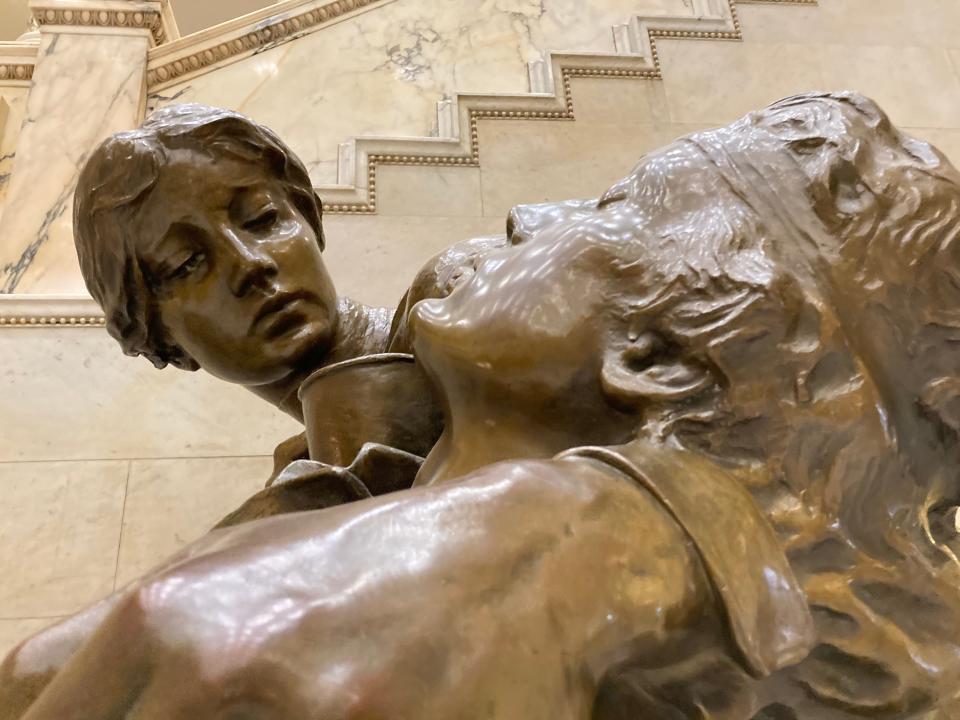
Historically, images of women did not enter the hallowed halls of Massachusetts governance until 1914, with the installation of a statue honoring Civil War Army nurses. The statue, created by Bela Pratt and loosely based on Michelangelo’s "Pietà," shows a wounded soldier resting against the strong shoulder of a nurse who offers him a cup.
The statue honors the 3,000 women who served as volunteer nurses in the Civil War. Since the statue was first unveiled under the watchful gaze of nurse veterans of the war, as well as survivors and descendants of deceased nurses, other plaques and memorials have been added to the space.
A plaque placed to the left of the statue bears the likeness of Clara Barton, the founder of the American Red Cross, who was from Oxford. Created by sculptor Robert Shure, it was added to the tableau in 2001. A different plaque commemorates another wartime nurse, Frances Slanger, killed by enemy action in World War II. Slanger grew up in Roxbury after immigrating from Poland.
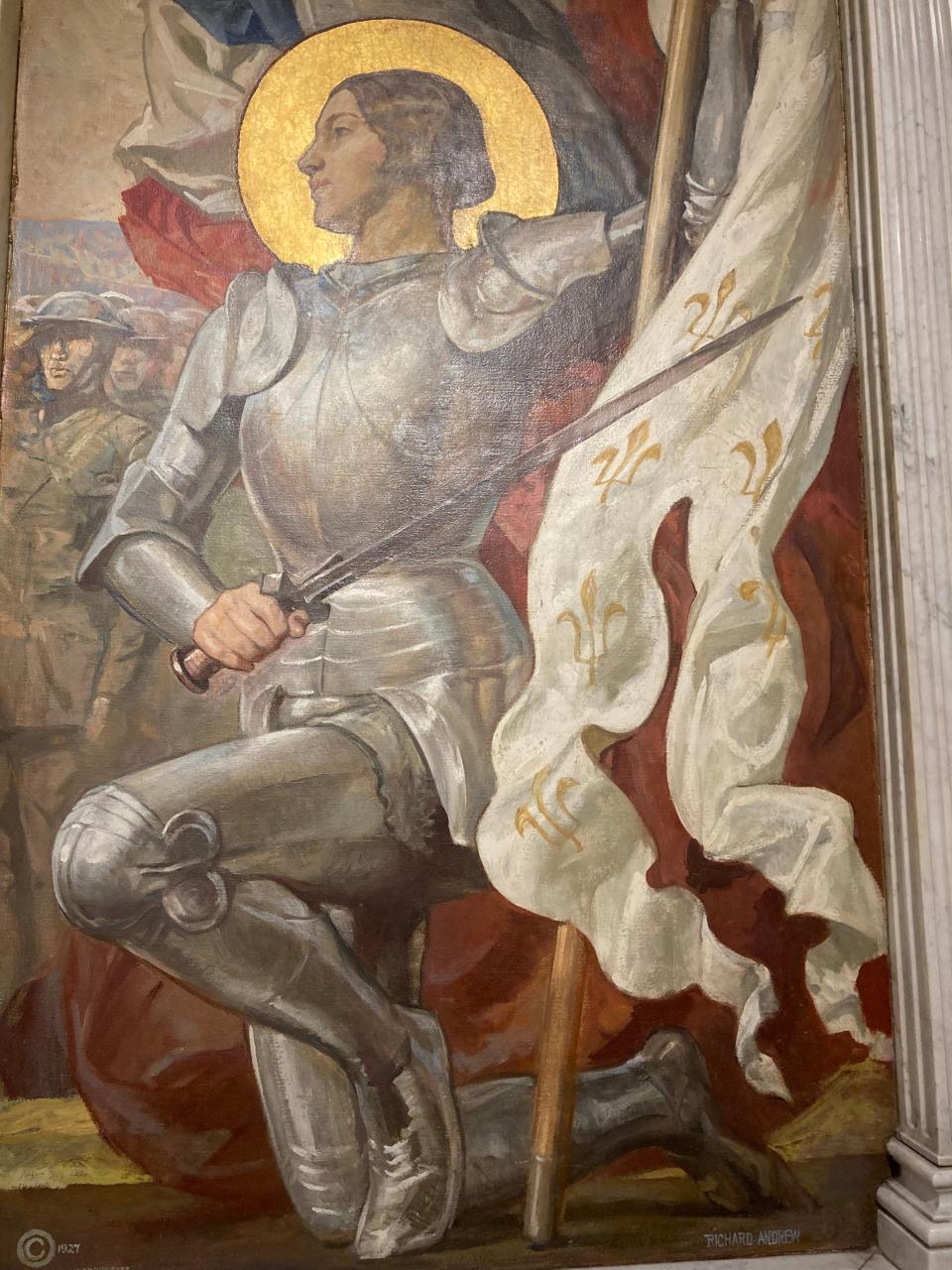
The fourth floor display is a rendition of a booklet first designed and disseminated in 2020 by the State House Art Commission to coincide with the anniversary of the Women's Memorial erected outside Doric Hall. It highlights art created by or depicting women throughout the State House grounds.
The display commemorates Women's History Month, and also coincides with a push launched by Senate President Karen Spilka, D-Ashland, to bring more diverse images into the State House.
“Representation matters,” Spilka said as she unveiled a bust of statesman and abolitionist Frederick Douglass in the Senate Chamber last month.
To that end, Spilka has reinvigorated the Senate Art Committee, first formed in 1972, that was dormant for decades, appointing Sen. Julian Cyr, D-Truro, to a leadership role. Spilka is also requesting state residents submit names of women who have served in leadership roles or made great contributions to the state.
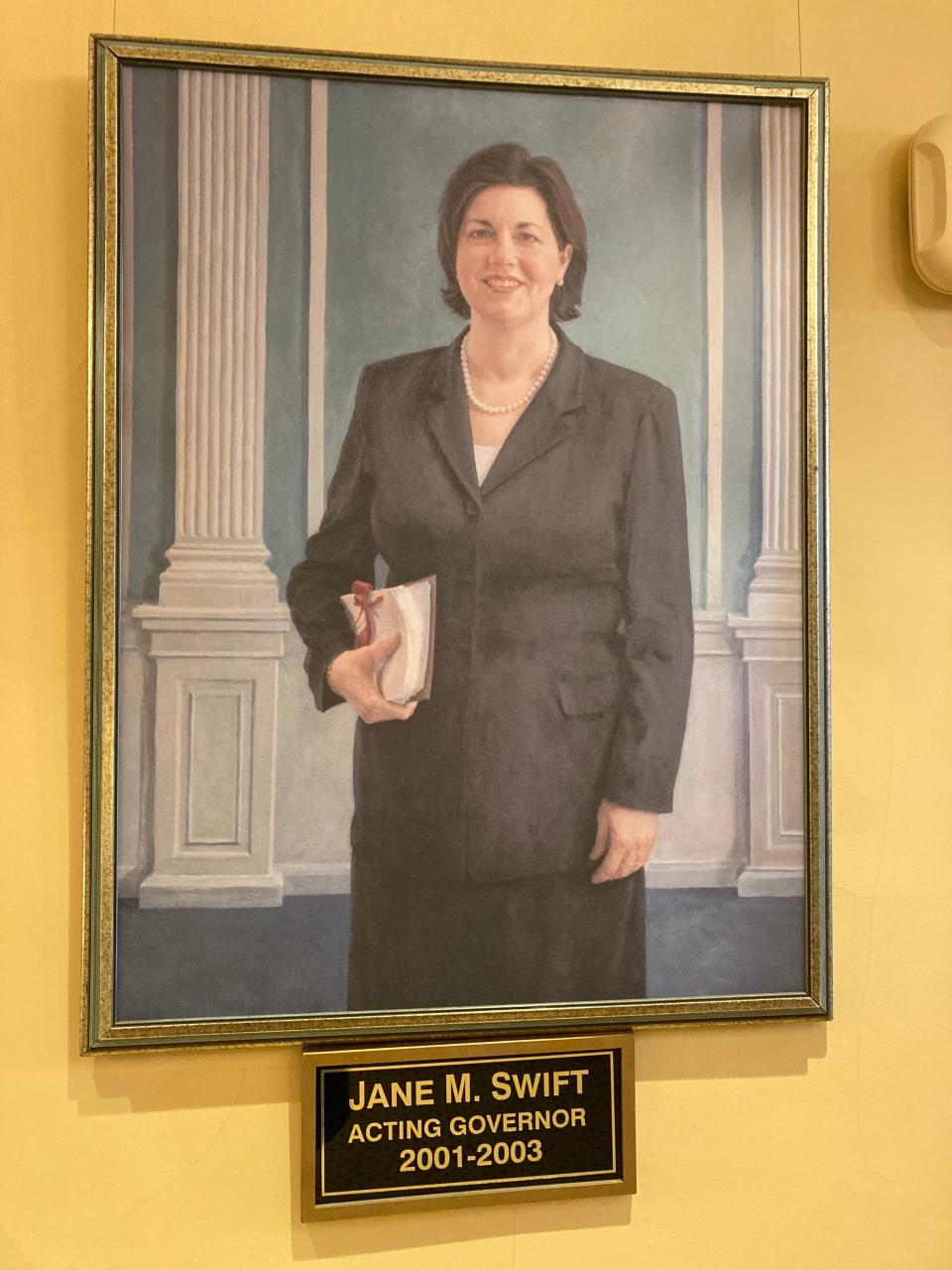
“For far too long decisions such as these have been made by a select few,” Spilka said, in a written statement announcing the request for proposals. “I’m excited to hear from our residents across the commonwealth about women they want to see honored by the Senate. Massachusetts is home to residents from a variety of backgrounds and everyone should be able to see themselves reflected in the art of the State House.”
Women, and their causes, grace the hallway
In Doric Hall, the hallway adjacent to the ceremonial doorway into the State House, is a wall of women.
“HEAR US: The Massachusetts Women’s Leadership Memorial" depicts six women considered highly influential:
Dorothea Dix (1818-1893), who grew up in Worcester and was a crusader in the field of mental health and a proponent of care for the mentally ill
Lucy Stone (1802-1887), a native of West Brookfield who lectured against slavery and was a leading suffragette
Sarah Parker Remond (1824-1894), a Salem native and abolitionist
Josephine St. Pierre Ruffin (1842-1924), a Boston writer and journalist who published the first newspaper written by and for African American women
Mary Kenney O’Sullivan (1846-1943), a Boston labor organizer who lobbied for laws protecting women and children and refused to do a “man’s job without a man’s pay”
Florence Luscomb (1887-1985), a Lowell native, suffragette, labor organizer and peace and civil rights advocate
The work, a multimedia experience that highlights a quote from each woman's life, uses a backdrop that resembles wallpaper. A closer look reveals that the patterns are really the words from legislation that highlights what the women were working toward: The removal of the criminally insane from state prisons; voting rights for women and people of color; and better employment conditions for women and children.
The wall of women was created in 1999 by three artists: Sheila DeBretteville, Susan Sellers and Robert Shure.
Shure also created the Fallen Firefighters Memorial outside the State House in Ashburton Park.
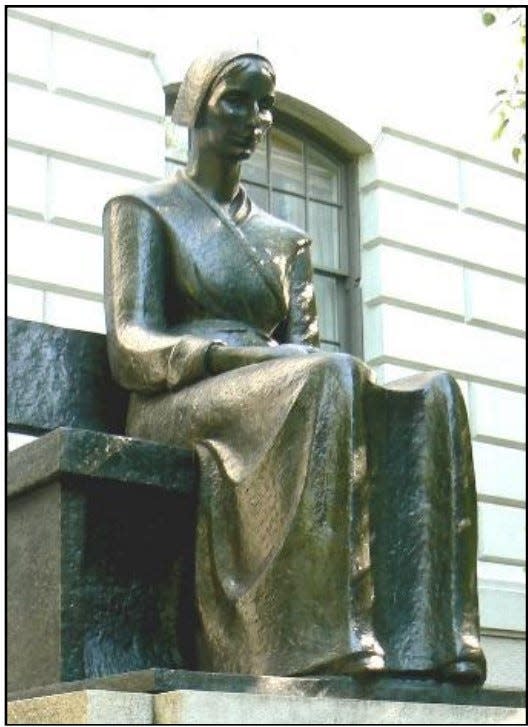
Sculptures, by and of women, are also included in the collection
Other women are represented in sculpture. Sitting quietly, eyes downcast, near the Hooker entrance, is Mary Dyer (1635-1660), who was hanged in Boston Common for being a Quaker. Her statue was created by artist Sylvia Shaw Judson Haskins and installed under the great shade trees, surrounded by spring daffodils and tulips in 1959.
In contrast Anne Hutchinson (1591-1643) — a teacher, spiritual advisor and critic of the Puritan faith — stands defiantly at the west entrance, eyes uplifted. Hutchinson is considered by some to be the nation’s first feminist. Her likeness was created by Cyrus Dallin and installed on Beacon Hill in 1922.
Included in the project are the women artists who contributed to works of art displayed in the building. Many were commissioned by the state to copy existing portraits.
"We were blessed to be in Boston and to have the Boston Museum School artists at our backdoor," said Susan Greendyke Lechevre, art collections manager. "They were top-drawer artists getting a wave of commissions; academically trained, Europe educated."
The women worked from the late 1800s to the early 1900s to copy existing images of past Massachusetts statesmen: Joseph Dudley (governor of the province of Massachusetts Bay from 1702 to 1715), whose image was reproduced by Lyle Durgin; Christopher Gore (governor of the state from 1809 to 1810), whose image was reproduced by Marie Danforth Paige; and Richard Bellingham (three-time governor of the Massachusetts Bay Colony, during the 17th century), whose image was copied from a portrait in a private collection in Ireland by Agnes Fletcher.
Portrait copies were commissioned, or painted and donated to the State House, when the originals were in private or institutional collections, Lechevre said, adding that it was a common practice. Several portraits of 19th century governors were painted from photographs after their deaths as they had not been painted during their lifetimes.
The collection grows slowly, Lechevre said, adding that much of the art and artifacts were added in the first 70 years of the State House's existence. Now, sponsors of a piece will work with the commission to find a suitable place for an item. The building, she said, is running out of wall space.
Two 21st-century gubernatorial portraits were painted by women: Sarah Belchetz-Sweson painted the portrait of Jane Swift, the state’s former lieutenant governor who served as acting governor after Paul Cellucci left for an ambassadorship in 2001; and Ellen Cooper, a Pennsylvania artist who produced the portrait of former Gov. Charlie Baker.
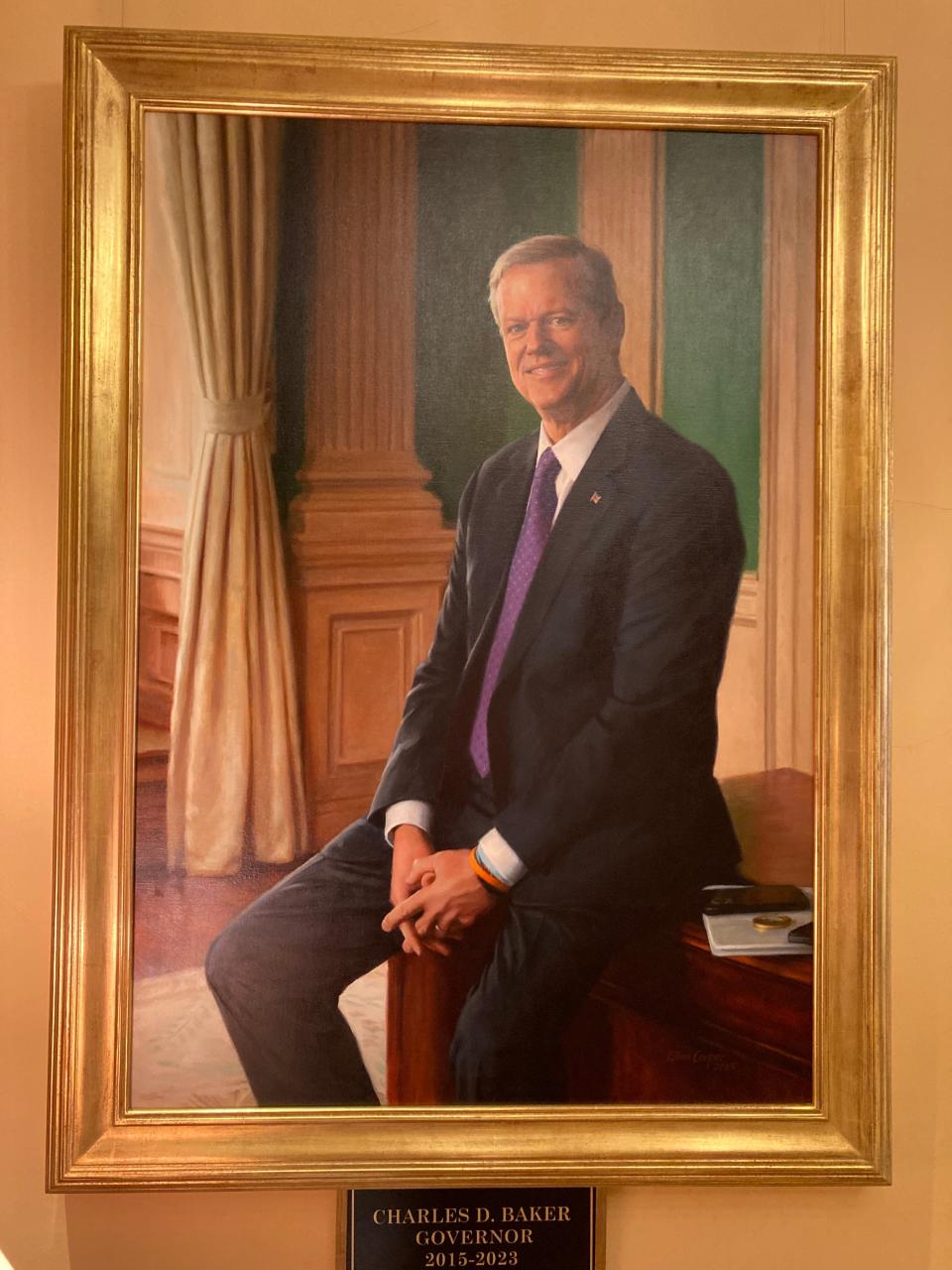
Other images of women in leadership share the walls of the State House with Swift, who was the state's first female governor.
Esther Andrews (1862-1938), the first woman to serve on the Governor’s Executive Committee, who also served as chair of the Bureau of Prisons, was the first woman to have her portrait adorn the walls.
Also showcased is Therese Murray, a Plymouth politician who served in the Senate from 1993 through 2015. She was the first female Senate president, serving in the role for eight years.
Murray’s portrait was produced by the team of Lucia and Warren Prosperi, with Lucia taking photographs and Warren wielding the paintbrush.
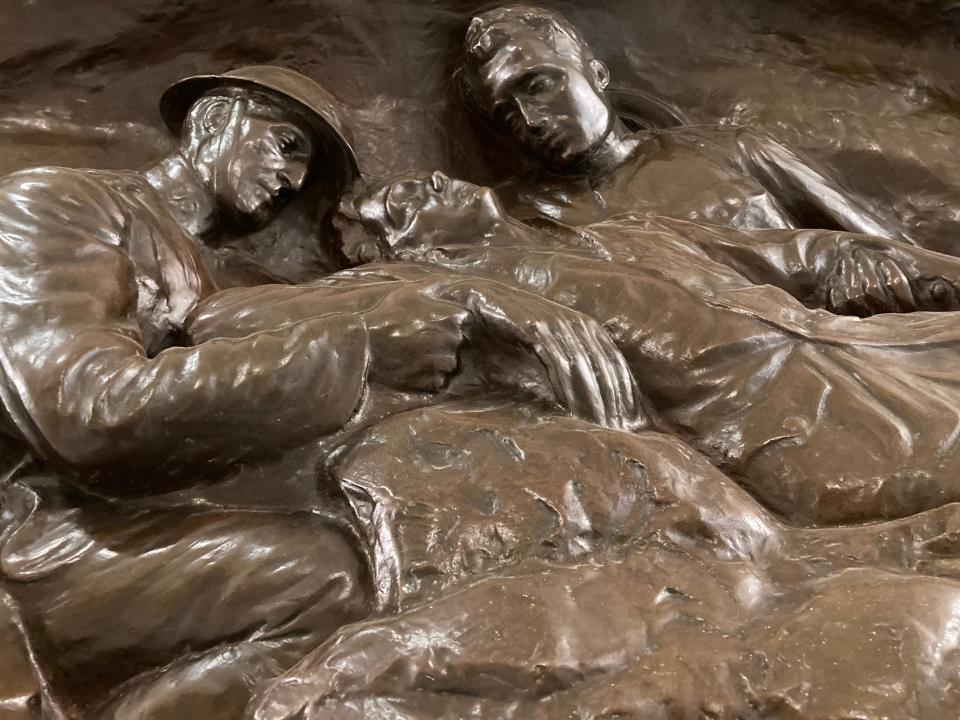
Not all the female artists represented in the State House are modern: sculptor Sarah F.C. Ames in 1867 created the bust of President Abraham Lincoln on display in the Senate Chambers; Emma Stebbins in 1865 sculpted the statue of Horace Mann, founder of the State Board of Education; Bashka Paeff, a student of Bela Pratt, created the Chaplain’s Memorial in 1922; and Isabel McIlvain sculpted the statute of President John F. Kennedy in 1990.
The display explaining and picturing each work is on view through the end of March.
This article originally appeared on Telegram & Gazette: Exploring women artists, and art of women, at the Mass. State House

